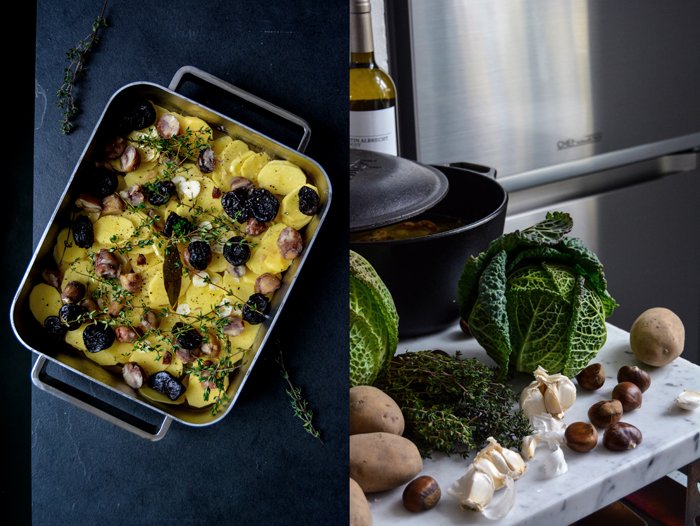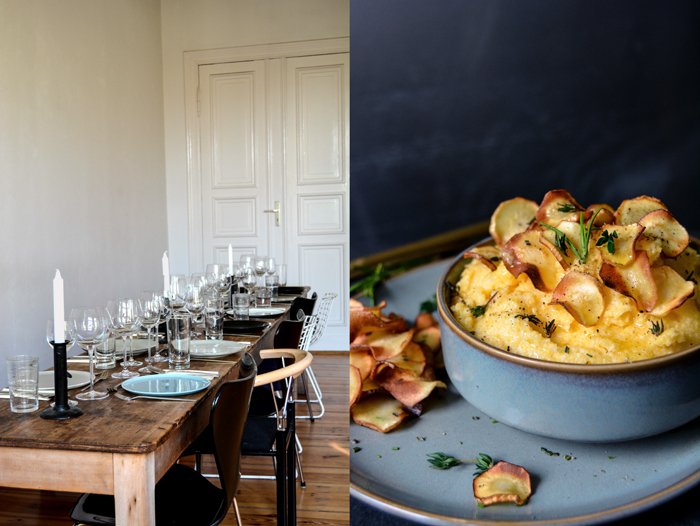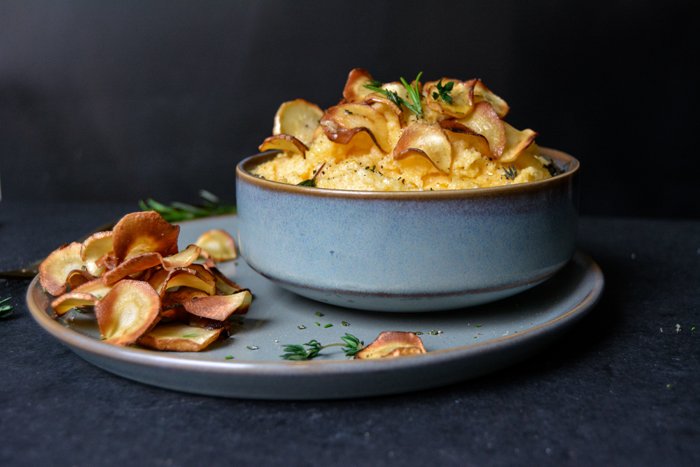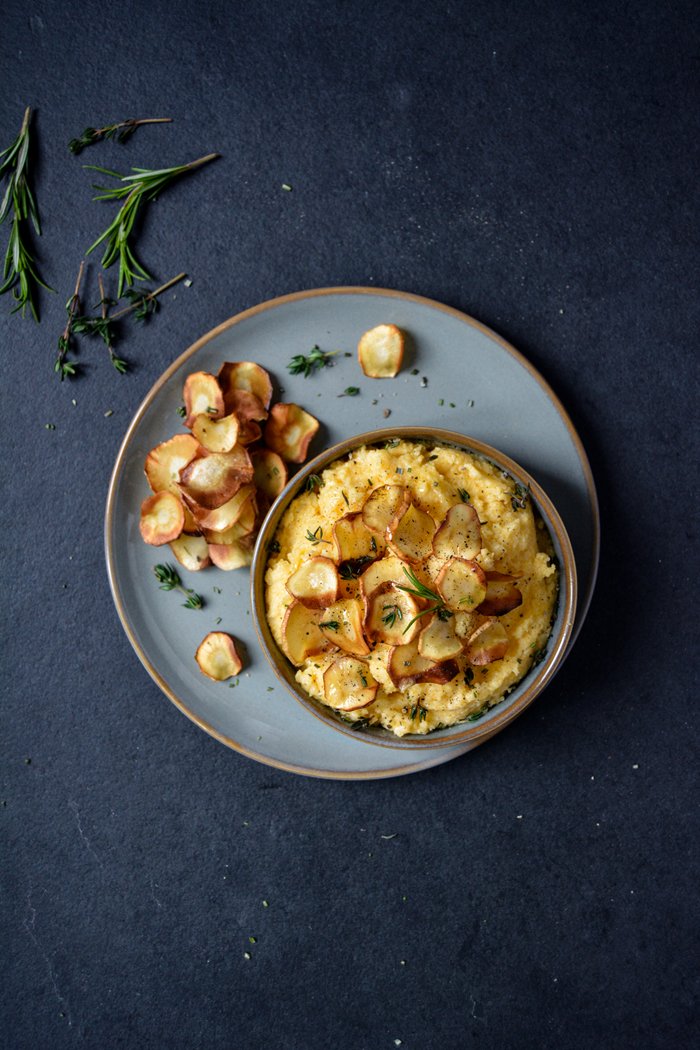Christmas Duck Confit with Roast Potatoes, Chestnuts, Plums, and Star Anise
Berlin, December 2015:
It's only a week until Christmas and I'm starting to get excited! The culinary plan for the holidays isn't complete yet, there are still a few important questions to discuss, but flambéed Christmas Pudding for dessert and my obligatory slow roasted duck are already on the list. In the past 2 years of eat in my kitchen, I shared 2 Christmas recipes with you that feature a whole duck cooked for hours at very low temperature. This year, I decided you deserve a break - although I'll still put mine in the oven, early, on the 24th for Christmas Eve, at 85°C / 185°F, as always.
Recently, I had another one of my food phone calls with my mother, we spoke about confit de canard, duck legs cooked in the oven for hours in a dutch oven full of the bird's fat. The meat is succulent and meltingly tender and - conveniently - you can use the fat that it cooked in for months to fry potatoes and sear your meat. It's the best! I decided to have a little pre-holiday-celebration and cook a Christmas-y duck confit roasted on crispy potatoes refined with chestnuts, dried plums, and star anise. Although the duck legs don't need as long as my whole Christmas duck, you'll need about 1 1/2 days in advance for the preparation. First, you marinate the meat in salt and herbs for a few hours, or preferably overnight. The next day, you'll cook the legs in the oven in 1kg / 2 1/4 pounds of duck or goose fat (for 4 legs), I used goose fat as I forgot to place my order at the butcher in time but it works just as well. It takes about 2 1/2 hours before the meat almost falls off the bones - it's beautifully tender but pale at that point. Now, you can either keep the duck confit in the fridge until you'll need it - you could even store it for months as long as it's completely covered in fat (although I have never tried that). Instead, I would turn the oven on the next day, lay the legs on top of thinly sliced potatoes and roast everything for about 30 minutes (plus 20 minutes for the potatoes before you lay the meat on top). You use some of the tasty fat - that you'll have plenty of - to cook the duck and vegetables to crisp and golden brown perfection. During this time, I cooked a bowl full of apple Savoy cabbage, fresh and light without cream but with tender bite instead.
If you spread the preparation over 2 1/2 days it's quite an easy Christmas lunch - or dinner - that doesn't actually demand much work, just the right logistics. And if you're still looking for some really good wine for Christmas, we already made our choice: We'll enjoy Martin Albrecht's Gelber Muskateller (Muscat) and his 2012 Herbstnebel (Syrah, Cabernet-Sauvignon and Nebbiolo)! I wrote about his fantastic wine a couple months ago, click here to find out more about his old vineyards in the south of Germany.
Apart from this culinary pre-celebration, there was also a pre-Christmas gift that I got overly excited about: we have a new fridge in the house! In the past few months, while cooking and baking even more than usual due to my book, I often suffered from my old fridge's limitations and I knew that something had to change sooner or later. I did some research behind the silver doors of today's chic refrigerators, which all look quite similar from the outside. I remembered a tall model by Samsung that had caught my attention last year but at that point, my 12-year old fridge was still fully functioning and I was still forgiving regarding its limitations. So when Samsung had invited me to a presentation of their latest Chef Collection, a series of kitchen appliances developed together with Michelin-starred chefs, I wasn't ready for a change yet. But as soon as they offered me this huge, elegant silver fridge, after months of trying to fit in all the vegetables that I needed to cook and shoot for my book, I said "Yes, please!" I got it - thank you so much for that Samsung - and I'm totally happy about the fact that it keeps the temperature constantly stable and is especially energy saving - and I particularly enjoy the telescopic slide out drawer at the bottom, the Chef Zone. Maybe this is how some people feel about cars, but these little details are more than just practical, this is fun! But first and foremost, it's huge compared to our old fridge and I love it. There's so much space that I haven't even managed to fill it yet but I'm sure this will change next week, once the Christmas shopping begins.
Duck Confit with Potatoes, Chestnuts, Plums and Star Anise
Serves 4
For the duck confit
coarse sea salt 1 1/2 tablespoons
black peppercorns, crushed in a mortar, 1 1/2 teaspoons
duck legs 4
fresh thyme 1 small bunch
duck or goose fat (jarred, or fresh uncooked goose fat from your butcher, cleaned from skins and veins, finely chopped) about 1 kg / 2 1/4 pounds
firm, sour apple, peeled, cored and sliced, 1
bay leaves 2
For the roast duck legs and potatoes
medium, waxy potatoes, peeled and very thinly sliced, 8
pre-cooked chestnuts 200g / 7 ounces
dried plums 150g / 5 ounces
garlic, thinly sliced, 3 cloves
star anise 3 pods
a small handful fresh thyme sprigs
fat used to cook the duck, about 180ml / 3/4 cup
coarse sea salt
black peppercorns, crushed in a mortar
For the apple Savoy cabbage
fat used to cook the duck 3 tablespoons
medium onion, finely chopped, 1
a small head of Savoy cabbage, cut into quarters, cored, roughly chopped, rinsed and slightly wet, about 500g /17 1/2 ounces
firm, sour apple, peeled, cored and roughly chopped, 1
dry white wine about, 300ml / 1 1/4 cups
nutmeg, preferably freshly grated
fine sea salt
ground pepper
Day 1
For the duck confit, combine the salt and pepper. Lay the duck legs in a baking dish, rub the skin with the salt-pepper mix and lay half the thyme under the meat and the other half on top. Cover with plastic wrap and keep in the fridge for a few hours, preferably overnight.
Day 2
Set the oven to 120°C / 250°F (conventional setting). Rub the salt off the duck legs with a paper towel, reserve the thyme sprigs.
Melt the (jarred) duck or goose fat in a large dutch oven over medium heat. If you use fresh goose fat from your butcher, let the cleaned and chopped fat cook over medium-high heat for 1 1/2 minutes or until the fat is melted. Take the dutch oven off the heat and let the fat cool for 2 minutes. Add the duck legs, the reserved thyme sprigs, the apple slices and bay leaves, everything should be covered in fat. Place the pot, uncovered, in the oven and cook for 2 1/2 hours. Take the dutch oven out of the oven and continue roasting the legs or cover the dutch oven and roast the legs the next day.
Once the duck legs are roasted you can pour the remaining fat in a sterilized jar and keep it in the fridge for months. It's great for fried potatoes, roasts and cabbages.
Day 3
Set the oven to 220°C / 425°F (conventional setting).
Spread the potatoes in a large baking sheet (don't use a small baking dish like in the picture below, I had to transfer them to a bigger sheet after 10 minutes as they were too moist). Add the chestnuts, plums, garlic, star anise, thyme, and fat, season with salt and pepper, and toss to combine with your fingers. Roast for 10 minutes, stir, and roast for another 10 minutes. Take the duck legs out of the fat - if the fat is hard place the dutch oven over medium heat to soften it - and lay them on top of the potatoes, skin side up. Roast in the oven for 25-30 minutes, stirring the potatoes every 10 minutes, or until crisp and golden brown.
While the potatoes are roasting, cook the cabbage: In a large pot, heat the fat over medium-high heat. Add the onion and cook for a few minutes until soft and golden. Add the cabbage and apple, stir, and cover. Lower the heat to medium and cook for 1 minute. Add the wine, nutmeg, salt and pepper and cook for 10-15 minutes or until the cabbage is just tender. Season to taste.
Arrange the duck legs and the potatoes on plates, serve with the cabbage filled in little bowls.
Herbed Polenta with Parsnip Chips and Maple Butter - and a feast!
The past few weeks have been an emotional roller coaster. I finished my English book and happily gave in all the recipes, text and pictures 3 days before my official deadline - something that had never happened before according to Holly, my editor, and it impressed her and the Prestel team in New York quite a bit. I just wanted to have everything off my desk at one point - and celebrate. And that's what we did!
Holly came to visit us in Berlin for a few days and all we did was talk and eat (and work on the cover for my book). We showed her around the city as it was her first time here and I planned a special dinner for her with some of the people at the table who have strongly influenced me during my eat in my kitchen blog and book experience. Not all of them could make it, but to see how many came and how some of them tried to make it possible truly touched me. Molly from My Name Is Yeh wanted to come from North Dakota just for this dinner, she even checked out the flights - this is crazy! - but she had to be in the States the day before and after. Thank you girl!!
Malin from The Bread Exchange came with her handsome baby boy Lode - in the early days of my blog we made sandwiches together with her bread and now we even share the same publisher (for her German book that will come out in the Spring of 2016). Marta from What Should I Eat For Breakfast Today? - my great inspiration for photography and positivity in life (this lady has the most beautiful smile!) and one of the first meet in your kitchen guests - was here to celebrate with us. And she took the pictures of us at the table, which I love because usually I'm the one taking pictures so I'm never in them. They truly show what a happy night we had, thank you Marta! Cynthia Barcomi - the founder of my favourite Berlin Deli - already had her cake for our dinner in the oven but sadly had to cancel at the last minute. Luckily, we didn't have to worry about having enough sweets on the table anyway. My apple cinnamon crumble was delicious and looked rather rustic next to Laura's elegant raw chocolate avocado cake. The Berlin Tausendsuend baker impressed all of us with her composition and took us right to chocolate heaven.
It was an amazing night with amazing people that I'll never forget. And a nice coincident gave us another reason to cling the glasses - in the same week of my deadline, my boyfriend finished the EP he produced for a fantastic artist from Australia. Josh The Cat happened to spend a lot of time at our apartment in the past few months for the production and became one of my book's first testers. He loved my recipes as much as I love his music and we shared far more than just food and songs this year, he and his girlfriend, the gorgeous artist Phia, became close friends of ours and we're more than sad that they'll soon leave us to go back to Australia. But I'm sure we'll hear more about their music soon!
A dinner becomes special through the people and conversations at the table, it's delicious through the right food - we enjoyed some of my book's recipes which I can't share with you yet - and it's a feast when you have good wine in the glasses. I have to send a big thank you to a man from the South and fantastic wine maker who made it possible for us to enjoy amazing wine on that special night. Martin took over the Weingut Robert Bauer - which is now called Martin Albrecht Weingut - more than 10 years ago, a wine maker who's filled my mother and step father's wine cellar since I was a child. You could certainly call it our family wine. With a family tradition of more than 400 years of producing wine, Martin comes from the right background to continue Mr. Bauer's philosophy of creating only the best wines - ohne Restzucker (without residual sugar). This is wine of the highest quality, which you can smell and taste with the first sip. We enjoyed an excellent Gelber Muskateller (Muscat) with an autumny, fruity soup and an outstanding 2012 Herbstnebel (Syrah, Cabernet-Sauvignon and Nebbiolo) with hearty lamb. I love this wine! We were over the moon with our treat from the Württemberg area. If you're looking for a wine, handpicked in old vineyards, a wine that guarantees to please your taste buds to the fullest and puts a smile on your face, get in touch with Martin through their website, or visit him in Flein (50km / 30 miles from Stuttgart). He also offers the best vinegars I know - his Balsamic Pear vinegar is one of my favourites, you can basically drink it off the spoon. Thank you Martin!
And thank you Holly for giving me a reason to bring all these great people together at our table!
I can't share the recipes with you from that night, we have to be a little more patient until my book comes out, but as we enjoyed a dish that featured scrumptious parsnip I decided to create a dish for you that fits the current mood of autumn and allows the roots to bring out their confident qualities - fluffy herbed polenta topped with crisp parsnip chips and sizzling maple butter.
Thank you to everyone who has been a part of this journey for making all this possible, it makes me a very happy person - and a happy cook!
Herbed Polenta with Parsnip Chips and Maple Butter
Serves 2
For the polenta
polenta 120g / 4 ounces
water 240ml / 1 cup
milk 240ml / 1 cup
salt 1 teaspoon
olive oil 2 tablespoons
For the parsnip chips
parsnip, very thinly sliced, 200g / 7 ounces
vegetable oil
fine sea salt
For the maple butter
butter 2 tablespoons
maple syrup 1/2-1 tablespoon
For the topping
fresh rosemary, finely chopped, 1-2 teaspoons
fresh thyme leaves, finely chopped, 1-2 teaspoons
ground pepper
In a saucepan, heat the water and milk, add the salt and bring to the boil. Take the pan off the heat, add the olive oil and polenta and whisk. Turn the heat down to the lowest setting and put the pan back on. Cook the polenta for 10 minutes, stirring and adding more water once in a while if necessary. When the polenta is thick and creamy, take if off the heat and season with salt to taste.
Heat a generous splash of vegetable oil in a heavy pan, the bottom should be covered. When the oil is hot, add the parsnip, just enough to lay them next to each other. Turn them after a few seconds and take them out immediately once they are golden and crisp but not too dark. Mind that they burn very quickly! Transfer the chips to kitchen paper and season with salt.
Melt the butter in a saucepan, whisk in the maple syrup when it's sizzling and take the pan off the heat.
Scrape the polenta into bowls and sprinkle with maple butter, parsnip chips, pepper and fresh herbs.





















